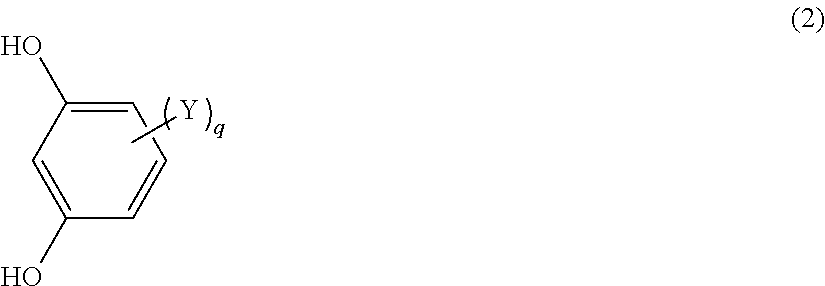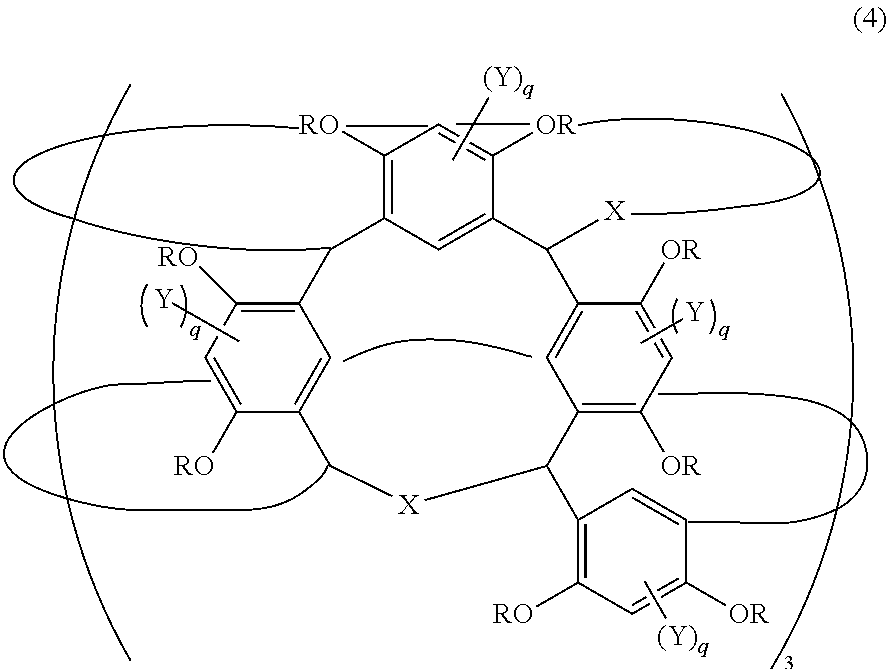Method for forming pattern
a pattern and pattern technology, applied in the field of pattern formation, can solve the problem of useless underlayer film
- Summary
- Abstract
- Description
- Claims
- Application Information
AI Technical Summary
Benefits of technology
Problems solved by technology
Method used
Image
Examples
synthesis example 1
Synthesis of Compound (A-1)
[0119]Resorcinol (2.20 g, 20 mmol) was dissolved in ethanol (4.5 mL), and hydrochloric acid (1.5 mL) was added to the mixture. The solution was ice-cooled to 5° C. with stirring, and a 50% aqueous solution of glutaraldehyde (0.40 g, 2 mmol) was slowly added dropwise. Thereafter, the mixture was heated at 80° C. for 48 hrs to obtain a yellow suspension. The suspension was poured into methanol, and the precipitated substance was collected by filtration, and washed with methanol three times. The obtained solid was dried under reduced pressure at room temperature for 24 hrs. As a result, a powdery pale yellow solid (S) was obtained (recovery: 0.43 g (yield: 79%)). The confirmation of the structure of the obtained pale yellow solid (S) was carried out using MALDI-TOF-MS (model: SHIMAZU / KRATOS matrix-assisted laser ionization time-of-flight mass spectrometry apparatus KOMPACT MALDI IV tDE, from Shimadzu Corporation), IR (model: FT-IR 420, manufactured by JASCO C...
synthesis example 2
Synthesis of Compound (A-2)
[0126]The method identical to that of Synthesis Example 1 was employed, except that 2-methyl-2-adamantyl bromoacetate (6.9 g) was changed to tert-butyl bromoacetate (4.7 g), and the compound represented by the above formula (A) (A-2) (3.5 g) was obtained. 1H-NMR analysis showed that the protection rate of the compound (A-2) (rate of substitution of the hydrogen atom of the phenolic hydroxyl group in the compound (A-2) with the tert-butoxycarbonylmethyl group) was 50%.
synthesis example 3
Synthesis of Resin (1)
[0127]Into a separable flask equipped with a thermometer, were charged 10 parts of 2,7-naphthalenediol / formaldehyde condensate (a hydroxy group-bearing resin), 20 parts of paratoluenesulfonic acid, and methylisobutyl ketone, and allowed to react at 50° C. for 6 hrs with stirring. After completing the reaction, the reaction solution was cooled at or below 30° C. by water cooling. The reaction solution was sequentially washed with 1% by mass of oxalic acid and pure water, the obtained organic layer was concentrated, and then the obtained concentrate was dried at 50° C. for 17 hrs, to obtain a resin (1).
PUM
| Property | Measurement | Unit |
|---|---|---|
| thickness | aaaaa | aaaaa |
| thickness | aaaaa | aaaaa |
| thickness | aaaaa | aaaaa |
Abstract
Description
Claims
Application Information
 Login to View More
Login to View More - R&D
- Intellectual Property
- Life Sciences
- Materials
- Tech Scout
- Unparalleled Data Quality
- Higher Quality Content
- 60% Fewer Hallucinations
Browse by: Latest US Patents, China's latest patents, Technical Efficacy Thesaurus, Application Domain, Technology Topic, Popular Technical Reports.
© 2025 PatSnap. All rights reserved.Legal|Privacy policy|Modern Slavery Act Transparency Statement|Sitemap|About US| Contact US: help@patsnap.com



